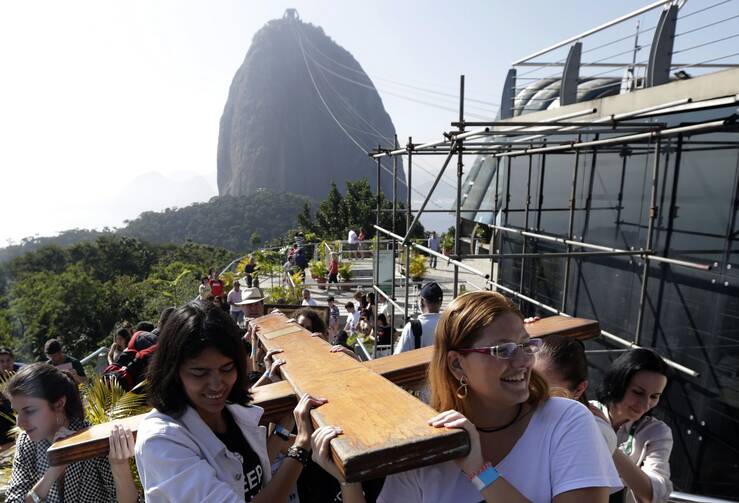As young Catholics from around the world await the arrival of Pope Francis in celebration of World Youth Day, the Pew Research Center issued a timely report on religion in Brazil today. It locates some unterrific, if not unexpected news on Catholicism in Brazil, where the church is challenged by the continuing ascent of Protestant churches, particularly the fast growing Pentecostal denominations, and an accelerating secularism and religious indifference, and, believe it or not, "spiritism."
Tracking a worldwide trend, the number of Brazilians with no religious affiliation, referred to as the "nones" (for none of the above) here in the United States, including agnostics and atheists, also has been growing. "In 1970, fewer than 1 million Brazilians had no religious affiliation. By 2000, that figure had jumped to 12 million (7 percent). In the most recent decade, the unaffiliated continued to rise, topping 15 million (8 percent) in Brazil’s 2010 census."
The new analysis also finds that the number of Brazilians belonging to other religions—"including Afro-Brazilian faiths such as Candomblé and Umbanda; spiritist movements like the one led by the late Chico Xavier; and global religions such as Buddhism and Islam"—has been climbing. About 2 million Brazilians belonged to these other religions in 1970. "By 2000, adherents of these other faiths had grown to about 6 million (4 percent of Brazil’s population), and as of 2010, they number nearly 10 million (5 percent)," researchers said.
Pew researchers report that the share of Brazil’s overall population that identifies as Catholic has been dropping steadily in recent decades. According to the report: "With an estimated 123 million Roman Catholics, Brazil has the largest Catholic population in the world. Between 1970 and 2000, the share of the population that identifies as Catholic fell even though the number of Catholics in the country rose. But in the most recent decade, from 2000 to 2010, both the absolute number and the percentage of Catholics declined. Brazil’s Catholic population fell slightly from 125 million in 2000 to 123 million a decade later, dropping from 74 percent to 65 percent of the country’s total population.
The survey also found that Brazilian Catholics tend to be older and rural, while Protestants tend to be slightly younger and concentrated in urban areas. "Brazilians with no religious affiliation also are younger, on average, than the population as a whole and are more likely to reside in urban settings." The report found negligible differences in educational attainment between Catholics, Protestants and unaffiliated in Brazil. But there was a notable difference in the levels achieved by "spiritists" and other religions. Pew found that a greater share of adults who have completed high school belong to "other religions" (9 percent) compared with those who have less education (4 percent). This is particularly true of Brazilians belonging to spiritist movements, according to the report. The share of spiritists who completed high school (70 percent) is almost twice as high as in the general public (36 percent).
Pew reports that the number of Brazilian Protestants, conversely, continued to grow in the most recent decade, rising from 26 million (15 percent) in 2000 to 42 million (22 percent) in 2010—"with a particularly notable rise" among Pentecostal churches which more than doubled since the 1991 census when about 6 percent of the population belonged to Pentecostal or neo-Pentecostal churches. By 2010, that share had grown to 13 percent. "Meanwhile," Pew reports, "the percentage of Brazilians who identify with historical Protestant denominations, such as Baptists and Presbyterians, has remained fairly steady over the last two decades at about 3 percent to 4 percent of the population. (The Brazilian census also contains a third category of Protestants, labeled “unclassified.” That group has grown from less than 1 percent of Brazil’s population in 1991 to 5 percent in 2010.)
Pew notes: "The rapid growth of Pentecostals and other Protestants in Brazil cannot be explained fully by demographic factors, such as fertility rates or immigration. Brazilian census data from 2000 indicate that total fertility rates for Protestants are about the same as for Catholics. In addition, less than 1 percent of Brazil’s population is foreign born—too small a percentage for immigration to make a significant difference in the religious composition of the country as a whole. Rather, the main factor in the growth of Protestantism in Brazil appears to be religious switching, or movement from one religious group to another." A 2006 Pew survey of Brazilian Pentecostals suggest that nearly half (45 percent) had converted from Catholicism.
The full report is available here.








